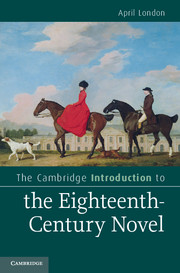Part II - Sociability and community
Published online by Cambridge University Press: 05 June 2012
Summary
Introduction
This part explores the forms of community that eighteenth-century novels envision as complement to the exceptional, isolated, and sometimes autonomous selves explored in the first three chapters. Chapter 4 opens with one of the period’s most celebratory accounts of relationships secured by kinship and marriage, Samuel Richardson’s last novel, Sir Charles Grandison (1753–4). Its orthodox articulation of a “family of love” provided a point of reference for numbers of succeeding works, including Oliver Goldsmith’s The Vicar of Wakefield (1766), a far less sanguine representation of the social power wielded by fathers. In another complementary pairing, Eliza Haywood’s Betsy Thoughtless (1751) and Jane Austen’s Emma (1815), it is the subjects, rather than the agents, of domestic patriarchy that are of primary interest. While each of these novels specifies grounds for criticizing the family, they all end by validating its authority to define individual, social, and political behavior. Chapter 4 closes with two works from the 1790s that use earlier novels to gain a purchase on their own far bleaker assessment of the politics of family: Eliza Fenwick’s 1795 Secresy adapts elements from Samuel Richardson’s Clarissa, while George Walker’s 1796 Theodore Cyphon re-writes the 1794 Caleb Williams (a work itself heavily indebted to Clarissa).
- Type
- Chapter
- Information
- Publisher: Cambridge University PressPrint publication year: 2012



